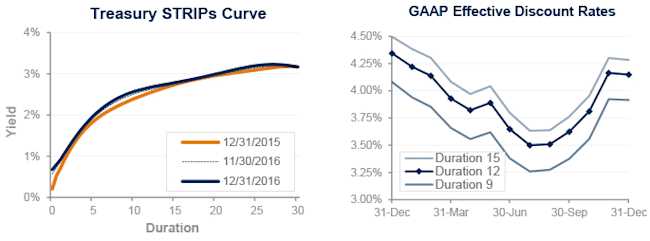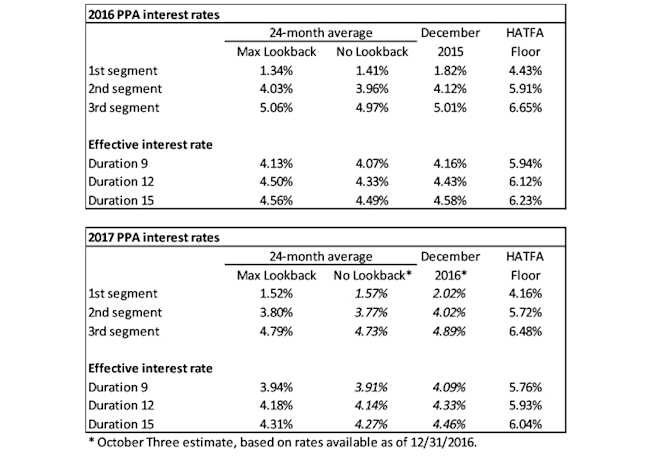December 2016 Pension Finance Update
For pension finance, the story of 2016 can read two different ways. If you fell asleep at the end of 2015 and just woke up today, it looks like a ho-hum year, in which both assets and liabilities grew by single digits, with asset growth slightly edging out liability increases. But if you followed daily market movements, 2016 was a harrowing ride, which saw funded status decline by 7% in the first half of the year before improving 8% in the second half. For the $2 trillion pension market in the US, this amounts to a loss of about $150 billion through June that was completely erased by year-end. Given that total corporate profits of US companies are about $1.5 trillion, and that many leading companies no longer sponsor pension plans, these are prodigious swings.
But it all came right by year-end. December saw tiny improvements for both model pension plans we track1 , and both Plan A and the more conservative Plan B by finished 2016 about 1% better than they began the year.

Assets
Stocks gained ground in December and ended the year with mostly solid performance. The S&P 500 was up 2% on the month, the NASDAQ gained 1%, the small-cap Russell 2000 was up almost 3%, and the overseas EAFE index advanced almost 2%. For the year, the Russell 2000 was the star, posting a 21% return, while the S&P 500 gained 12%, the NASDAQ was up 8%, and the EAFE index gained less than 1%.
A diversified stock portfolio gained 2% during December and 10% in total during 2016.
Interest rates ended the month close to unchanged (Treasuries were up a couple basis points, corporate bonds down a couple basis points during December), producing earnings of less than 1% on the month. For the year, corporate bonds gained 5%-8%, with longer duration bonds doing best, while Treasuries gained just 1%-3%, so a diversified bond portfolio likely earned 3%-5% during 2016.
Overall, our traditional 60/40 portfolio gained more than 1% during December and 7%-8% for all of 2016, while the conservative 20/80 portfolio also added 1% last month and 6%-7% for the year.
Liabilities
Pension liabilities (for funding, accounting, and de-risking purposes) are now driven by market interest rates. The graph on the left compares Treasury STRIPs yields at December 31, 2015 and December 31, 2016, and also shows the movement in rates last month. The graph on the right shows our estimate of movements in effective GAAP discount rates for pension obligations of various duration during 2016:

Treasury interest rates ended 2016 very close to where they started the year, while corporate bond yields fell about 0.20% during the year, with the difference reflecting a tightening of credit spreads of almost 0.25% during 2016. Rates ended the year 0.7%-0.8% higher than the all-time lows seen as recently as last July. The fall in corporate bond yields pushed pension liabilities up 6%-8% during 2016, with long duration plans seeing the biggest increases.
Summary
Overall, pension assets outgrew pension liabilities by 1% during 2016, despite an awful start to the year for stocks and record low interest rates seen last summer. Given where we were six months ago, this is a result pension sponsors should be feeling pretty good about.
The graphs below show the movement of assets and liabilities for our two model plans this year:

Looking Ahead
Congress passed a budget in 2015 that includes a third round of pension funding relief since 2012. The upshot is that pension funding requirements over the next several years will not be appreciably affected by current low interest rates (unless these rates persist). Required contributions for the next few years will be lower and more stable than under prior law.
Discount rates dropped a smidgen last month. We expect most pension sponsors will use effective discount rates in the 3.8%-4.4% range to measure pension liabilities at the end of 2016.
The table below summarizes rates that plan sponsors are required to use for IRS funding purposes for 2016, along with estimates for 2017. Pre-relief, both 24-month averages and December ‘spot’ rates, which are still required for some calculations, such as PBGC premiums, are also included.

1 Plan A is a traditional plan (duration 12 at 5.5%) with a 60/40 asset allocation, while Plan B is a cash balance plan (duration 9 at 5.5%) with a 20/80 allocation with a greater emphasis on corporate and long-duration bonds. For both plans, we assume the plan is 100% funded at the beginning of the year and ignore benefit accruals, contributions, and benefit payments in order to isolate the financial performance of plan assets versus liabilities.
